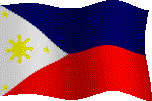 |
Philippine Surnames |
 |
 |
Philippine Surnames |
 |
Question # 1: Why do many Filipinos have Spanish surnames?
Answer Came From Norman Owen -- e-mail: ngowen@hku.hk
For the first several hundred years of Spanish rule, most Filipino surnames were either indigenous (e.g., Macapagal) or the names of Saints or other Catholic symbols (San Jose, de la Cruz, de los Reyes, etc.). Frequently, members of the same family did not have the same "surname" which drove Spanish officials crazy since they were trying to keep the tax rolls straight.
So in 1849, under Governor General Narciso Claveria, they issued a huge "Alphabetical Catalogue of Surnames" (Catalogo Alfabetico de Apellidos -- republished by the National Archives in 1973), which is just page after page of names, some Spanish, some Filipino, compiled by friars and bureaucrats from various sources. In theory, every Filipino was supposed to pick a name from this approved list, and all members of the same family were supposed to have the same surname and stick to it.
In practice, implementation was very uneven. In some provinces, e.g. Albay, the governor apparently tore out pages from the Catalogue and sent them to individual towns. Hence, almost everyone in the town had names beginning with the same letter ("B" in Tiwi, "R" in Oas, etc.) In other provinces, it was much more random. A lot of people kept old surnames (including "de los Santos" and the like) even though the decree supposedly forbade this. However, most Filipinos have family names which date back only to 1849 and to the "Catalogue" issued by Claveria.
Most of the Filipino-Chinese surnames date from the 19th century and later when most Chinese immigrants came to the Philippines. Names ending with "-go" or "-co" or "-son" often reflect contractions of generic terms or honorifics.
For more details on the Claveria decree, read the introduction to the 1973 edition of the _Catalogo Alfabetico de Apellidos_. See Edgar Wickberg, _The Chinese in Philippine Life, 1850-1898_ for the origin of Filipino-Chinese surnames.
Question # 2: Various Subjects
I was led to believe that, early during the Spanish occupation Filipinos had only a single name (ie no 'family' name).
The Spanish then decreed that all 'natives' must select a name from a list provided by the occupation government. Broadly speaking, the choice was restricted alphabetically to good old Spanish names (properly Christian and all that, rather than the 'witch doctor' mumbo jumbo of the locals, don't y'know old chap), depending on which part of the country one came from.
Thus, for example, new surnames beginning with 'A' to 'C' (Alvarez, Concepcion, etc) would come from the north - Ilocos, Cagayan, etc - with 'W', 'X', 'Y' and 'Z ' from the south (Southern Mindanao). The idea was to keep tabs on the unruly blighters!
My wife's family name begins with 'L' and she is from Samar, so that kinda fits.
I'd be interested if anyone can confirm this explanation, or even expand on the information.
[Answer Came From: Norman Owen, Department of History, University of Hongkong.]
> I was led to believe that, early during the Spanish occupation Filipinos > had only a single name (ie no 'family' name). Not quite. Many (most, according to the parish records) had two names, or even three. Unfortunately -- from an administrative viewpoint -- in many cases none of these was a proper 'family' name, in the sense that parents and children shared it. So you could have Juan Francisco married to Maria Clara and their children might be Tomas San Carlos and Maria Candelaria. You also had people changing their name frequently, so that Juan Francisco may also show up as Juan San Francisco, and/or Francisco San Juan, and maybe Juan Santos or Juan Salvador ... Obviously it didn't confuse the Filipinos themselves -- they clearly knew who they were -- but it did confuse the government (and potentially the church, which was trying to make certain cousins didn't marry each other within certain degrees of consanguinity). > The Spanish then decreed that all 'natives' must select a name from a > list provided by the occupation government. Broadly speaking, the choice > was restricted alphabetically to good old Spanish names (properly > Christian and all that, rather than the 'witch doctor' mumbo jumbo of > the locals, don't y'know old chap), Not really. The Catalogo Alfabetico de Apellidos, issued in 1849 (I have a copy of the 1973 reprint) included *tens of thousands* of Filipino names as well as Spanish ones -- I suspect actually more, though so far as I know no one has ever counted. (There are about 70,000 names listed, I would estimate) Priests were asked to supply names of plants, etc., in local dialects to be used. Opening at random I find: bapa, bapul, bapuyos, baquerin, baqueriza, baquero, baqueros, baquiano, baqui, baquiao, baquillas ... and so forth, nearly 500 names a page. The only restrictions were on the names of actual Spanish nobility (can't have "indios" passing themselves off as hidalgos) and a few extremely common names (e.g., de los Santos), which wouldn't solve the problem of administrative confusion. > depending on which part of the country one came from. > Thus, for example, new surnames beginning with 'A' to 'C' (Alvarez, > Concepcion etc) would come from the north - Ilocos, Cagayan etc - with > 'W', 'X', 'Y' and 'Z ' from the south (Southern Mindanao). Not exactly. Each provincial governor was -- as best I can figure it out -- given the complete "Catalogo" and told to go sort out everyone in the province, to make sure they all had proper family names, with the children having the same name as their father, and no unnecessary duplication, etc. The implementation of this varied widely. In some provinces, apparently they didn't much bother at all. In some (e.g., Camarines) each town would get a sprinkling of new names, presumably selected or assigned from the whole list. In others (e.g., Albay), they apparently worked alphabetically through the list (maybe they tore out pages?) so that all (or almost all) the new names in one town would begin with A, the next B, the next C, and so forth. Oas was nearly all "R," so jokingly they would, in the 20th century, claim people like Rizal and Roosevelt -- must be from Oas, just look at the family name! > The idea was to keep tabs on the unruly blighters! Absolutely right. That's what it was all about. > My wife's family name begins with 'L' and she is from Samar, so that > kinda fits. Coincidence, at least in the archipelago-wide framework. I'd be interested as to whether her townmates mostly have/had last names beginnings with L also. > I'd be interested if anyone can confirm this explanation, or even expand > on the information. I've tried to do so. I should point out that there were also a few families which had pretty much settled on a "family" name beforehand and kept it after 1849, in apparent defiance of the decree. As always, in the Spanish Philippines, there was a huge gap between policy and reality. Most of the information here can be found in the introduction to the 1973 Catalogo, which is nominally by Domingo Abella (though I was actually the "ghost-writer"). On the incomplete implementation, the best source is the parish records from before and after 1849, wherein you can (sometimes) find the actual shifts: Maria Oldname becomes (for a few years) Maria Newname Oldname becomes (eventually) Maria Newname. > Last names like Maglaban, Magtanggol, Mangahas, Magtabog, Magsalin, > Maghasik, Maglinaw, Magbitang, Sumulong, Sumibol, Sumilang, Lumaban, > Liwanag, Tagumpay, etc. are quite authentic. The most probable reason > they were allowed to retain such last names and not adapt a Christian > name is perhaps they were among the clans/tribes most influential ones > with a significantly "fighter-sounding" names that the church preferred > to collaborate with them by not forcing them to change names. Thus, they > are probably among the ruling elite/sultans and datus at the time. I'm not sure about this. The enforced name change comes almost 300 years after the conquest, so powerful datus of the 16th century would not necessarily have been still acknowledged by the Spanish (but see below for a very few families). On the other hand, such families may simply have had a greater interest in preserving a "family" name, which would have suited the Spanish fine. As noted, the decree was *not* in general designed to force Filipinos to give up indigenous names, simply to make sure that they could be identified by "proper" surnames, of whatever origin. > Whatever happened to the (Si)Katunas, Sulaymans, Matandas, etc? > If you can prove that your family had been using the same last name for > three generations, you were allowed to keep it whether it was a local > name (allowed anyway and listed in the catálogo) or the name of a saint > (frowned upon, normally). The major exception to this was names "like de la Cruz, de los Santos, and some others which are so numerous that they would continue producing confusion." But the number of Filipinos still named (de la) Cruz or indeed (de la) Santos (thank you, Hector!) indicates how imperfectly this was implemented. > Sulaiman, et al were restricted in their use since the very beginning to > the descendants of those royal people. This is because they had special > privileges with regards to taxes and other matters guarranteed by the > Spanish regime. The decree specifies (article 8): "To avoid confusion which might result to the prejudice of those who with their surnames inherited from His Majesty certain benefits, the names of Lacandola, Mojica, Tupas, and Raja Matanda shall not be adopted except by those who have a just title to possess them."
Special thanks to Mr. Norman Owen, Department of History, University of Hongkong for the responses provided above.
Return to PhilGenWeb Project
This web site maintained by Precy T. Ordinario of Carson, California, USA.